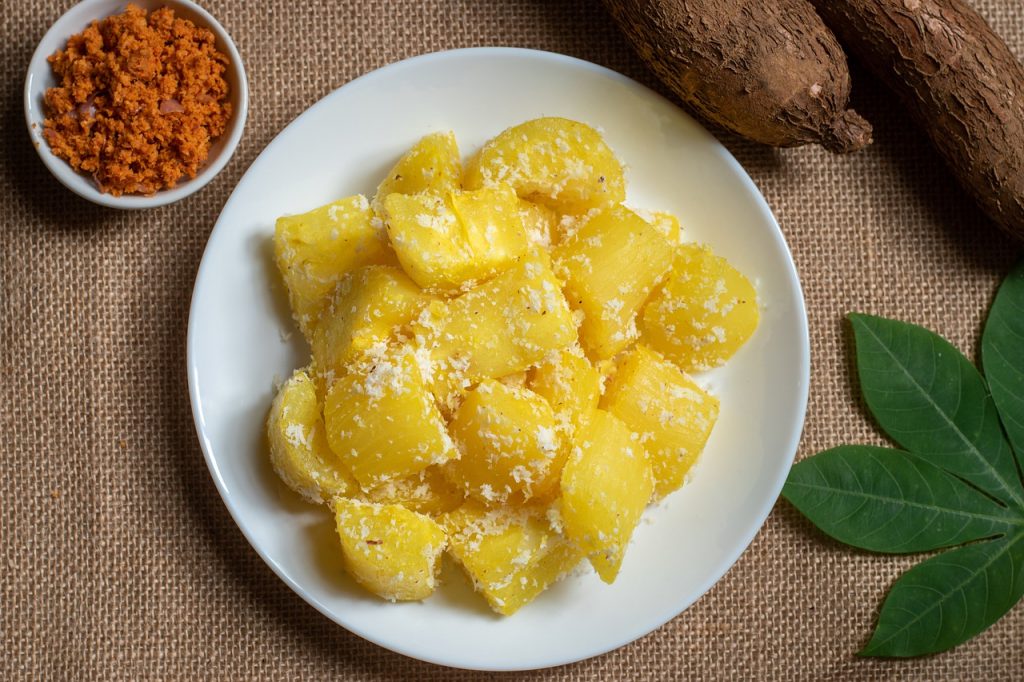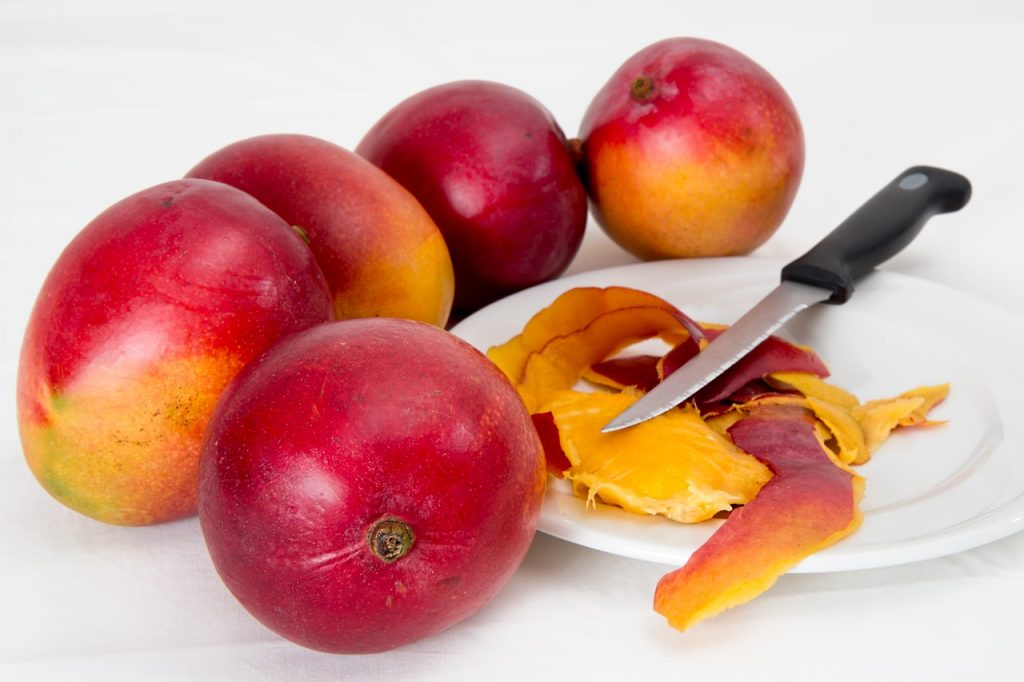[Article updated on 19/09/2023]
Vegetables and fruits play a fundamental role in the proper functioning of the body. Due to their relatively low energy, fat and carbohydrate content, they play an important role in reducing the risk of many diseases. Thanks to their high content of vitamins, minerals and antioxidants, they have a beneficial effect on maintaining the body’s acid-base balance. Their high dietary fiber content promotes proper intestinal functioning, provides a feeling of satiety and has a beneficial effect on the metabolism of fats and carbohydrates in our body. To help you better benefit from the beneficial effects of these foods, here is the list of vegetables and fruits starting with M.
Cassava
Cassava is a root vegetable. It is the tuberous root of Manihot esculenta, a tropical plant belonging to the botanical family Euphorbiaceae. Cassava is similar to a potato, which can reach 8 cm in diameter and 1 m in length. Each root weighs 3 to 10 kg. There is a lot of starch in these root vegetables. The raw roots are very toxic and are only used boiled or baked. Raw cassava is used to make tapioca, a popular dish in many countries.

Dried cassava is ground into flour. From this flour fine cakes, called cassava bread, are made. The leaf blades are also used to make soups. Cassava is a rich source of carbohydrates (around 90%). It contains 20-40% starch, around 5% simple sugars and around 2% protein. This vegetable also contains vitamins (A, B1, B2, B3, B6, B9 and C), minerals (potassium, calcium, magnesium), as well as resveratrol. 100 g of cassava provides approximately 159 kcals. Cassava has a low glycemic index and does not contain gluten. It is therefore very often recommended in a variety of diets.
Chewed up
Lamb’s lettuce is a leafy vegetable. It is harvested from Valerianella locusta L., a herbaceous plant belonging to the Caprifoliaceae family. Lamb’s lettuce is a lettuce-like plant with small leaves. However, compared to salads, it stands out not only for the size of the leaves, but also for its exceptional nutritional value. It is recommended to eat it raw. Lamb’s lettuce is used in various types of salads. You can also add lamb’s lettuce to vegetable smoothies. It goes well with both fruits and vegetables. It’s a great addition to meats like chicken.
Lamb’s lettuce accentuates the taste of cheeses, such as feta. The lamb’s lettuce is very low in calories. Therefore, it is ideal for people who want to lose extra pounds. Lamb’s lettuce is rich in beta-carotene and mineral salts. It contains vitamins (A, B6 and C), as well as minerals such as zinc, calcium, sodium, iron, potassium, magnesium and phosphorus.
Blueberry
The blueberry, also called cornflower, is the fruit of Vaccinium corymbosum, a shrub belonging to the Ericaceae family. The fruit is a berry 5-16 mm in diameter with a flared crown at the tip. Blueberries are first pale greenish, then reddish purple, and finally uniformly blue when ripe. They are covered with a protective layer of epicuticular wax. When ripe, they generally have a sweet taste with varying acidity.
Blueberries are a popular and versatile ingredient in cooking, thanks to their sour note. They are used for sweet and savory recipes. The fruits are eaten fresh or made into jams, juices or pies. In France and Italy, blueberries are used as a base for liqueurs and are a popular flavoring for sorbets and other desserts. In Brittany, they are often used as flavorings for pancakes.
In the Vosges and the Massif Central, blueberry tart is a very popular traditional dessert. The great nutritional qualities of blueberries also result from the presence of vitamins A and C, but also vitamins B1, B2, PP and mineral salts essential for our body (calcium, phosphorus, iron, sodium and potassium). These nutrients, aided by anthocyanosides, effectively inhibit the formation of free radicals.
Blackberry
Blackberries are the fruits of species of the genus Morus. The mulberry belongs to the Rosaceae family. The blackberry is a sweet, juicy fruit with a reddish-black color, tending to be shiny. It has a sweet and sour taste and reaches its full maturity during the summer months. In cooking, blackberries are a very versatile fruit. From jam to delicious homemade cakes, these small fruits are widely used to enrich sweet and savory recipes, from the most classic to the most original. Cultivated blackberries stand out for their high content of dietary fiber, vitamin C and vitamin K. A 100 gram serving of raw blackberries provides 180 kilojoules (43 kcal) and 5 grams of dietary fiber.
Blackberries contain a good amount of folic acid, essential for pregnant women, especially in the first months of gestation. Already in ancient times, mulberry leaves were used to prepare herbal teas and decoctions useful to combat gastric ulcers and to soothe gastrointestinal disorders. Tea obtained from root extract is a natural antidote against intestinal disorders and a powerful ally in the fight against diarrhea.
Mirabelle
The mirabelle plum is the fruit of Prunus europea subsp. initiated, a subspecies of plum. The mirabelle plum is a specialty of French Lorraine, which benefits from an ideal climate and soil for growing this fruit. This region produces 15,000 tonnes of Mirabelle plums per year, which constitutes 80% of world production..
Mirabelle plums have a medium or long peduncle and do not have a peduncle cavity. Their apex is rounded, as is their caudal base. The suture line is also absent. The color of the skin is golden yellow, with reddish reflections in the sun. The color of the pulp is golden yellow when fully ripe and its consistency is always high. The pulp, which separates well from the stone, is very juicy and slightly aromatic. The taste is pleasant and sweet and sour.
The mirabelle plum is a fruit that is found on the stalls mainly in August and September. Mirabelle plums are good sources of vitamins B and C and are also rich in potassium and magnesium. Like plums, they have a high pectin content and promote digestion.
Melon
Melon is the fruit of Cucumis melo, an annual climbing plant of the Cucurbitaceae family. The melon is a large fruit, round or oval in shape. Smooth or slightly wrinkled, the color of the melon skin varies from pale yellow to greenish. With a color that varies from white to orange, the pulp of the melon is, when ripe, juicy and very fragrant. In the center of the fruit is a fibrous central cavity filled with seeds. Basically, melon is eaten raw, cut into slices, without the skin.
Melon is also dried or processed into melon honey, jam, and candied fruits. The seeds of certain varieties are used to make melon oil. Some varieties of melon are grown for their pleasant scent. In Japan, there are liqueurs flavored with melon. Melon is a low-calorie fruit, with only 34 calories per 100 grams. 100 grams of melon provides more than 60% of the recommended daily intake of vitamin C and 21% of the recommended daily intake of vitamin A. Melons are also rich in carotene and folate.
Mango
Mango is the fruit of the mango tree (Mangifera indica), a plant belonging to the Anacardiaceae family. The fruit is a drupe, whose size, shape, color and taste qualities vary depending on the cultivar. Thus, the fruits can be yellow, orange, red or green in color. Fruits can be somewhat round, oval, or kidney-shaped. They range in size from 5 to 25 centimeters in length and weigh from 140 grams to 2 kilograms.

Mango has a sweet taste reminiscent of notes of peaches and pineapple with a hint of orange. It is suitable for making different recipes for ice cream, granitas, soft drinks, sweets and desserts. From the mango you can also extract a tasty juice. Mango is mainly composed of water (83%) and contains a good amount of fiber (1.6%). It is rich in mineral salts, including potassium, calcium, phosphorus, magnesium and zinc. It provides vitamins B, E, but is above all very rich in vitamin C.
Mangosteen
Mangosteen is the fruit of the mangosteen tree (Garcinia mangostana), a tropical evergreen tree belonging to the Clusiaceae family. The edible fruit has a rounded shape, with a diameter of approximately 5-7 cm. The pulp is an aril which is divided into 4 to 8 edible, fragrant and creamy lobes. It has a milky white color, with a vague peach and lychee flavor. Mangosteens are available fresh, canned and frozen in Western countries. Fruit can be served as dessert or
transformed into jams. In Vietnam, the ripe fruit is also used as an ingredient in salads. It contains a significant amount of fiber and carbohydrates, as well as vitamins, calcium, potassium and iron. It is a decidedly low-calorie fruit with a very low intake of fats and proteins. It is free of cholesterol. Thanks to its digestive properties, this tropical fruit is indicated in cases of abdominal bloating or to prevent the formation of intestinal gas. It also helps fight diarrhea and intestinal constipation.
Mandarin
The tangerine is the fruit of Citrus reticulata, a fruit tree belonging to the Rutaceae family. The fruit is spheroidal in shape, slightly flattened at the root, and is easily picked. The pulp is light orange in color. It is made up of easily separable segments, very juicy and sweet, within which numerous seeds are immersed. The bark is orange, subtle and fragrant. The skin is thin, loose, with a thin white mesocarp.
Tangerines are therefore generally easier to peel and divide into segments. Tangerines are usually peeled and eaten fresh or used in salads, desserts and main dishes. The skin is used fresh, whole, grated or dried. It can be used as a spice for cooking, baking, drinks or sweets. Very rich in vitamin C, mandarin is also rich in fiber and carotene. It also has appreciable amounts of vitamins B and A, as well as a substantial percentage of iron, magnesium and folic acid.
